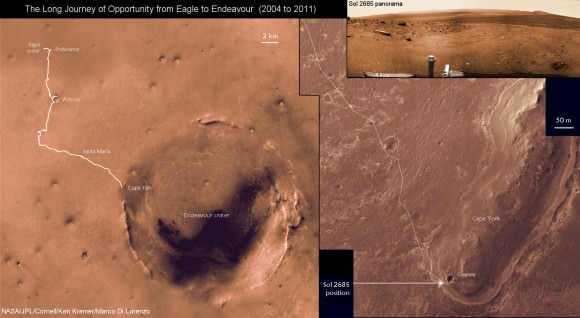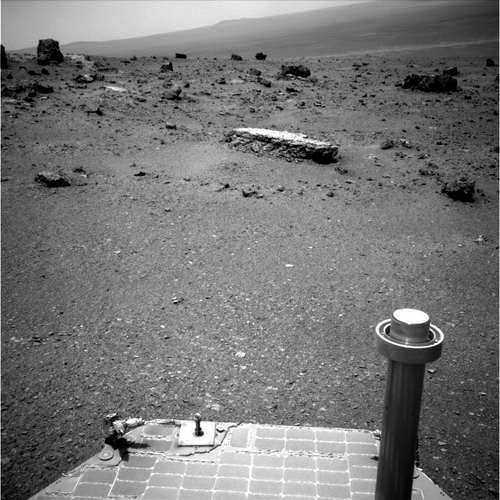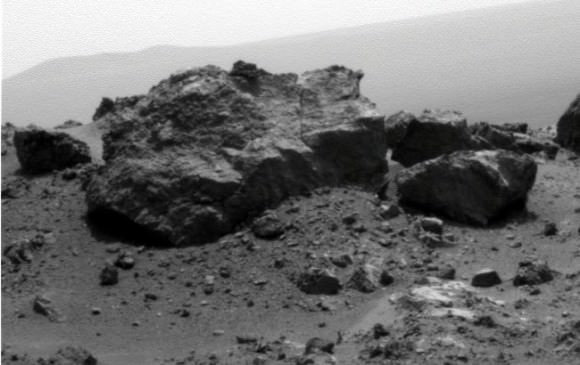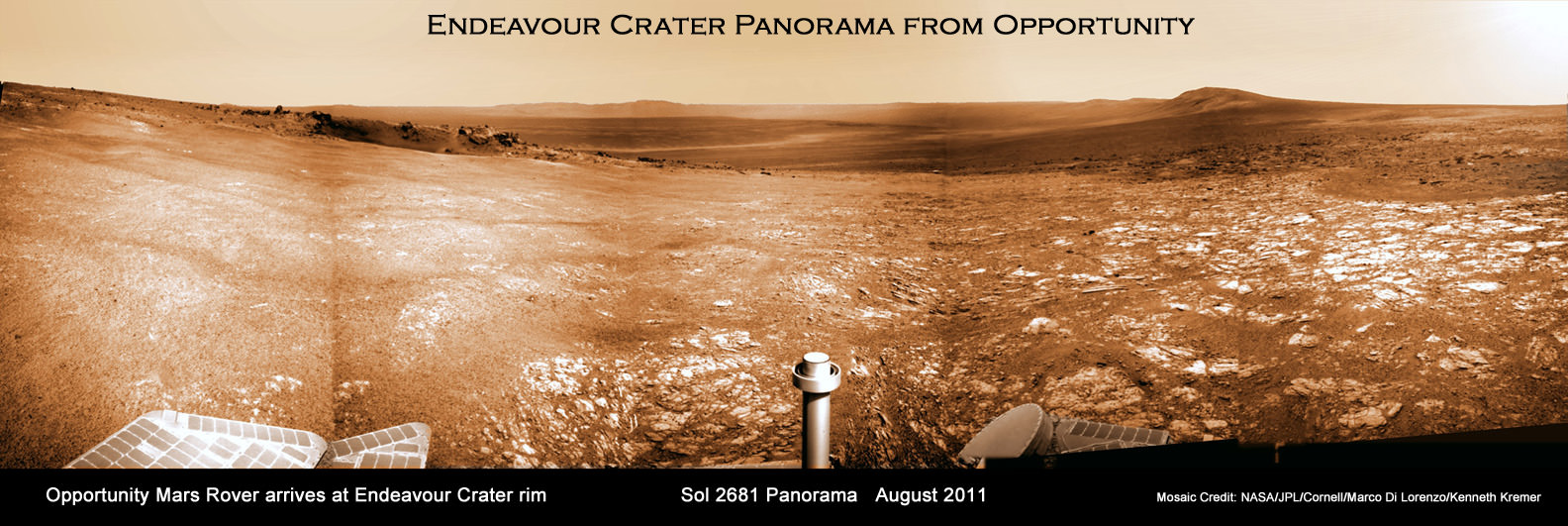[/caption]NASA’s Mars Opportunity rover has finally arrived at the huge Martian crater named Endeavour that simultaneously offers a mother lode of superb scenery and potentially the “Mother of all Martian Science”. The epic journey took nearly three years.
The intrepid robogirl is now climbing uphill on a Scientific quest that may well produce bountiful results towards the most important findings ever related to the search for life on Mars. Opportunity arrived at the western rim of the 13 mile (21 km) wide Endeavour crater on the 2681st Sol , or Martian day, of a mission only warrantied to last 90 Sols.
See our new Opportunity panoramic mosaics (Marco Di Lorenzo & Ken Kremer) illustrating the magnificent scenery and science targets now at hand on the surface of the Red Planet, thanks to the diligent work of the science and engineering teams who created the twin Mars Exploration Rover (MER) vehicles – Spirit & Opportunity.
Opportunity made landfall at Endeavour at a ridge of the discontinuous crater rim named Cape York and at a spot dubbed “Spirit Point” – in honor or her twin sister Spirit which stopped communicating with Earth about a year ago following more than six years of active science duty. See traverse map mosaic.
The martian robot quickly started driving northwards up the gnetle slopes of Cape York and has reached a small crater named “Odyssey” – the first science target, Dr. Matt Golembek told Universe Today. Golembek is a Senior Research Scientist with the Mars Exploration Program at the Jet Propulsion Laboratory (JPL) in Pasadena, Calif.
“Large ejecta blocks are clearly visible on the rim of Odyssey crater,” said Golembek. The crater is about 66 feet (20 m) in diameter.
Odyssey is a small impact crater of interest to the team because it features exposed material from Mars ancient Noachian era that was ejected when the crater was excavated long ago. Opportunity carefully drove over several days to one of those ejecta blocks – a flat topped rock nicknamed Tisdale 2.

NASA’s Opportunity Mars rover arrived at the rim of huge Endeavour crater on Sol 2681, August 9, 2011 and is climbed up the ridge known as Cape York. She drove to the flat topped Tisdale 2 rock at upper left to analyze it with the science instruments on the robotic arm. Opportunity snapped this soaring panorama showing distant portions of Endeavour’s rim - as far as 13 miles away - in the background. This photo mosaic was stitched together from raw images taken by Opportunity on Sol 2685.
Mosaic Credit: NASA/JPL/Cornell/Marco Di Lorenzo/Kenneth Kremer
“Opportunity is at a block of Odyssey crater ejecta called Tisdale 2 and the rock appears different from anything else we have seen,” Golembek explained.
Starting on Sol 2688 (Aug. 16) the rover began a science campaign time to investigate the rock with the instruments at the terminus of its robotic arm or IDD (Instrument Deployment Device) that will continue for some period of time.
“We are about to start an IDD campaign,” Golembek stated.

This map mosaic shows Opportunity’s epic trek of nearly eight years from landing at Eagle crater on January 24, 2004 to arrival at the giant 13 mile (21 km) diameter Endeavour crater in August 2011. Opportunity arrived the Endeavour’s rim and then drove up a ridge named Cape York. The photomosaic at top right show the outlook from Cape York on Sol 2685 (August 2011).
Mosaic Credit: NASA/JPL/Cornell/Kenneth Kremer/Marco Di Lorenzo
The team reports that the soil at Cape York is also of a different texture than any that Opportunity has seen so far on her incredible 20 mile (33 km) trek across the Meridiani Planum region of Mars. So far they haven’t seen of the iron-rich concretions, nicknamed “blueberries,” which have been plentiful on the surface along the way at numerous locations Opportunity has stopped at and investigated over the past 90 months. Initially the prime mission was projected to last 3 months – the remainder has been a huge bonus.
The science team is directing Opportunity to hunt for clay minerals, also known as phyllosilicates, that could unlock the secrets of an ancient Epoch on Mars stretching back billions and billions of years ago that was far wetter and very likely more habitable and welcoming to life’s genesis.
Phyllosilicate minerals form in neutral water that would be vastly more friendly to any potential Martian life forms – if they ever existed in the past or present. Signatures for phyllosilicates were detected by the CRISM instrument aboard NASA’s powerful Mars Reconnaissance Orbiter (MRO) spacecraft circling Mars


Read my continuing features about Mars starting here
Opportunity Snaps Gorgeous Vistas nearing the Foothills of Giant Endeavour Crater
Dramatic New NASA Animation Depicts Next Mars Rover in Action
Opportunity Rover Heads for Spirit Point to Honor Dead Martian Sister; Science Team Tributes
Opportunity Rover Completes Exploration of fascinating Santa Maria Crater
Opportunity Surpasses 30 KM Driving and Snaps Skylab Crater in 3 D


Already an IDD, huh?
– The Mini-TES is on the fritz.
– The AXPS uses an 244Cm alpha source, or at least the MSL version does. With a half-life of 18.1 years, an analysis will take no longer than before.
– However, the Mössbauer spectrometer uses 57Co gamma source with a halflife of 272 days. The original analysis time of ~ 10 hours will now be something like ~ 10*2^10, or 10 000 hours (!). Uh oh.
I assume they go for a low resolution MB spectra if at all. Unfortunately it can take days to get an analysis.
On the gripping hand, IIRC the phyllosilicate signal was from an area near the top of Cape York. So we may get some clay to play with “soon”.
Oh hells yeah. Been waiting for this.
“towards the most important findings ever related to the search for life on Mars.” Fingers crossed that this aging robot girl will stumble across something along those lines! And congratulations to the rover team! 🙂
But to be clear: IMHO the most important finding related to life on Mars to-date has been the Viking LR results! They should have been followed up in the last 35 years as they still have not been fully replicated by pure chemistry or physics so according to current knowledge of Mars and occam’s razor it most likely detected some kind of metabolism in Martian soil!
Several investigations followed up the results, of course. I’m sure you can find them by googling.
IIRC the signal was rather soon confirmed as consistent with Earth contamination (from isotope ratios). Specifically some craft cleaning agent used for the craft. Ironically when speaking of Occam’s razor, btw.
With unshielded UV at the Mars surface no organics, so no life, is expected for quite some depth. I believe the Phoenix perchlorate finds confirmed the heavy oxidation occurring.
The cleaning agent which was found accounts for the GC/MS which was not part of the life detection package.
The LR results were not due to earth contaminants unless a very hardy microbe happened to survive on the shovel arm which got the soil samples into the LR test chambers. Regarding UV-irradiation: did you know that a sample for the LR experiment was taken from under a rock (UV shielded for geologic times)? And guess what: it also yielded positive results including the nil response of the sterilized (by heat) control sample (like all other control runs of positive active samples)! There is a lot of information/facts about/from the LR experiment being ignored by the “scientific community”. I really would like to know why…
When you hear hoof-beats in Central Park, NYC, do you think of a mounted policeman or a zebra?
Doesn’t anyone get a uncontrollable urge to suspect the presence of an Indricotherium?
I believe (without checking) that the MS results were predicting the results of the other experiments, i.e. the cleaning agent was responsible.
As I noted above, the UV radiation makes an oxidative chemistry. That permeates where the UV doesn’t reach, as Phoenix confirmed. So the environment beneath rocks and as far as the Viking scope reached is predicted to be non-organic.
“I really would like to know why…”
Somehow I doubt that, since the papers tells why and you seem to ignore that. I think the consensus is that Mars surface is sterile. (Either oxidized outside the poles or deep frozen where massive amounts of CO2/water ices locally reverse that.) And that the Viking experiments confirmed that.
The no organics detection (which in fact is the main argument against the positive LR results being due to microbes) also accounts for the Viking GC-MS which (oh! oh!) is heavily contented currently due to pyrolisis seems to not be the right approach to detect organics on Mars (exactly because of putative perchlorates and other agressive stuff and also a bit of low sensibility compared to the LRx)
Yet the results of the LR experiment remains! As sad already: still no pure chemical or physical approach duplicated the full LR data after 35 years. The only near 100% duplication succeeded with soil from the antarctic dry valleys due to microbes in it!
@IVAN3MAN_AT_LARGE: In this case the mounted policeman are microbes detected by the labeled release experiment on Mars to a ever increasing likelhood as more and more facts about mars accumulates which supports the LR results 😉
There is no conclusive evidence that Martian microbes were detected – period!
Says who? I say – like an increasing number of respected scientists – the LR provided conclusive evidence for metabolism in the Martian soils tested (both, Viking 1 and 2)
Why should the LR data not be conclusive while the now heavily questioned (by scientific reasons described in my former replies) Viking GCMS is? Are you accusing Nasa of sending totally inconclusive life detection experiments to Mars and wasting a billiard of tax $?
Its a matter of fact that the LRx results seems to prevail – inform yourself.
The sterile Mars theory more and more becoming an extraordinary claim 🙂
The majority of astro-biologists say so – that’s who!
Used to say so yes – buts thats more like vintage meanwhile. 😉
The comment column here is getting somewhat thin – like your ‘evidence’!
Yes its so much more confortable to ignore facts which one dont want to understand…so keep follow the water ans speculating about life on Mars rather than follow the facts.
The no organics detection (which in fact is the main argument against the positive LR results being due to microbes) also accounts for the Viking GC-MS which (oh! oh!) is heavily contented currently due to pyrolisis seems to not be the right approach to detect organics on Mars (exactly because of putative perchlorates and other agressive stuff and also a bit of low sensibility compared to the LRx)
Yet the results of the LR experiment remains! As sad already: still no pure chemical or physical approach duplicated the full LR data after 35 years. The only near 100% duplication succeeded with soil from the antarctic dry valleys due to microbes in it!
@IVAN3MAN_AT_LARGE: In this case the mounted policeman are microbes detected by the labeled release experiment on Mars to a ever increasing likelhood as more and more facts about mars accumulates which supports the LR results 😉
The cleaning agent which was found accounts for the GC/MS which was not part of the life detection package.
The LR results were not due to earth contaminants unless a very hardy microbe happened to survive on the shovel arm which got the soil samples into the LR test chambers. Regarding UV-irradiation: did you know that a sample for the LR experiment was taken from under a rock (UV shielded for geologic times)? And guess what: it also yielded positive results including the nil response of the sterilized (by heat) control sample (like all other control runs of positive active samples)! There is a lot of information/facts about/from the LR experiment being ignored by the “scientific community”. I really would like to know why…